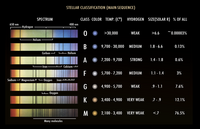Stellar classification

Imagine you have a bunch of different toys, but they're all different sizes and shapes. You might want to sort them out and put them in groups.
Now, imagine that instead of toys, we're talking about stars in space! Just like toys, stars come in different sizes, shapes, and brightness levels. Scientists use something called stellar classification to sort them out and put them in groups based on their characteristics.
The first thing scientists look at is the star's brightness. They use a tool called a spectroscope to break apart the star's light and then measure how much energy is given off at different wavelengths. This information helps scientists determine the star's temperature, which is important because it affects how bright the star appears to us on Earth.
Next, scientists look at the star's color. This can also give them clues about the star's temperature. For example, a star that appears blue is hotter than a star that appears red.
Finally, scientists look at the size of the star. They use something called the Hertzsprung-Russell (H-R) diagram to plot the stars based on their temperature and brightness. This helps them see patterns and group stars into categories, such as red giants or white dwarfs.
So, just like you might sort your toys by size, shape, or color, scientists sort stars by their temperature, brightness, and size using stellar classification.
Now, imagine that instead of toys, we're talking about stars in space! Just like toys, stars come in different sizes, shapes, and brightness levels. Scientists use something called stellar classification to sort them out and put them in groups based on their characteristics.
The first thing scientists look at is the star's brightness. They use a tool called a spectroscope to break apart the star's light and then measure how much energy is given off at different wavelengths. This information helps scientists determine the star's temperature, which is important because it affects how bright the star appears to us on Earth.
Next, scientists look at the star's color. This can also give them clues about the star's temperature. For example, a star that appears blue is hotter than a star that appears red.
Finally, scientists look at the size of the star. They use something called the Hertzsprung-Russell (H-R) diagram to plot the stars based on their temperature and brightness. This helps them see patterns and group stars into categories, such as red giants or white dwarfs.
So, just like you might sort your toys by size, shape, or color, scientists sort stars by their temperature, brightness, and size using stellar classification.
Related topics others have asked about:
